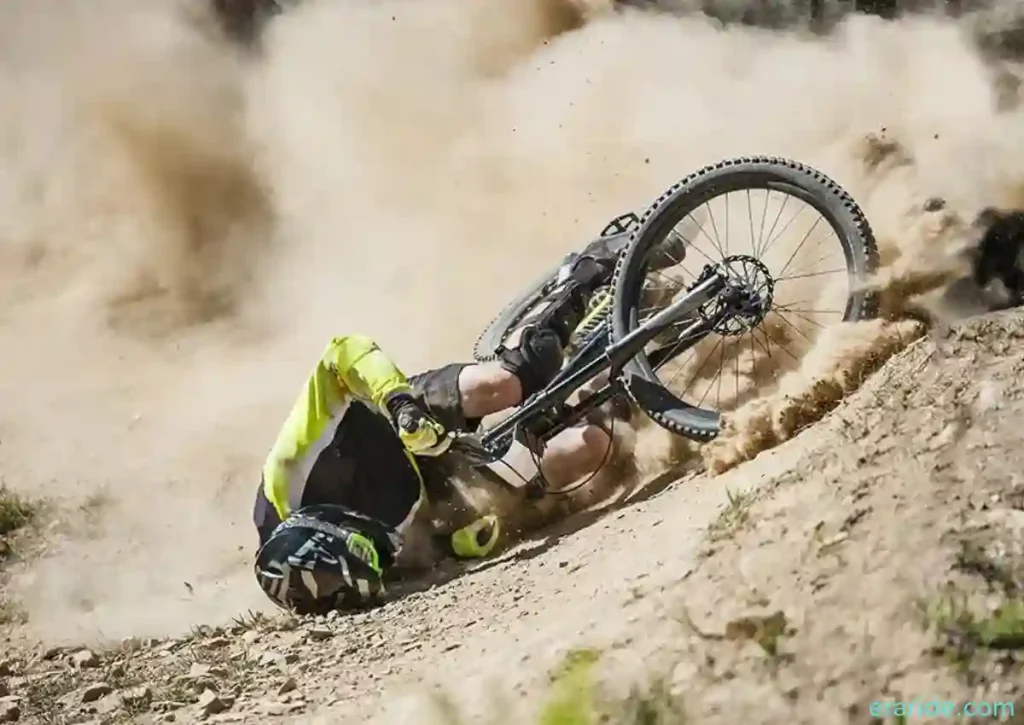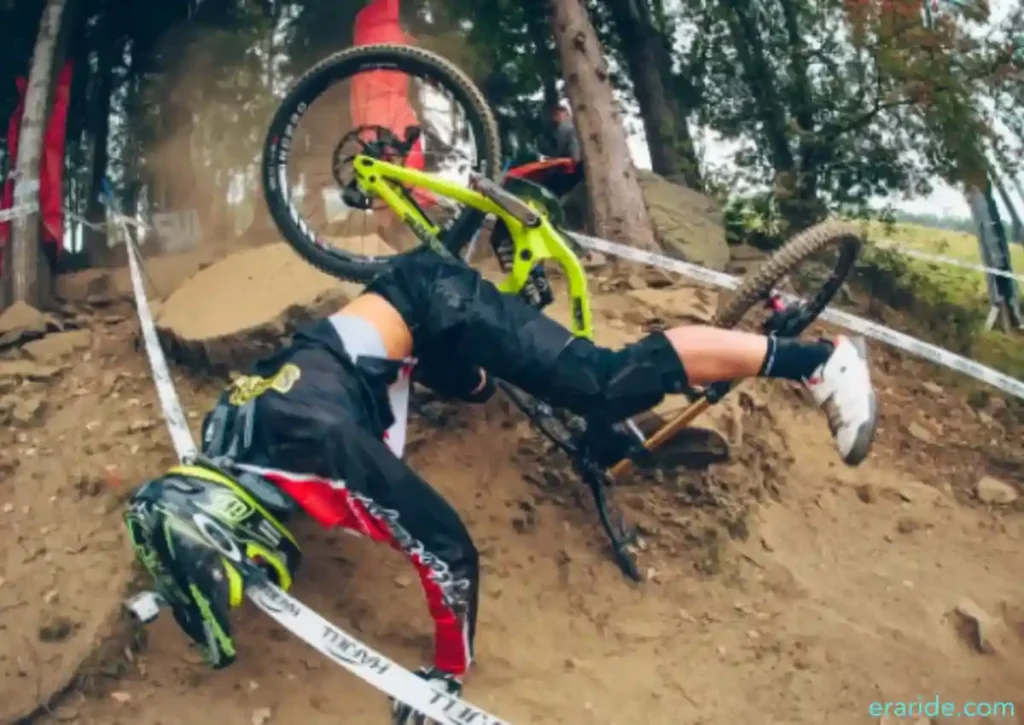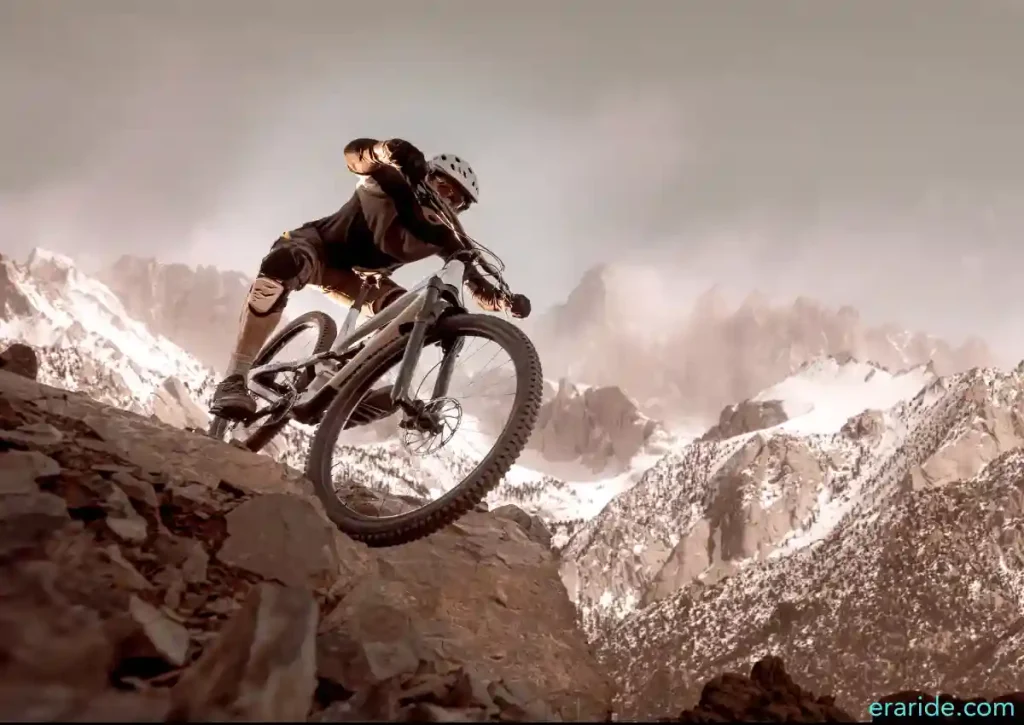Mountain biking can be dangerous, with risk factors including falls, collisions, poor trail conditions, and competition.
Approximately 70% of injuries occur on downhill slopes, jumps, and challenging terrain.
To minimize risks, cyclists should follow safety tips such as wearing protective gear, maintaining their bikes, and being cautious on unfamiliar trails.
However, with proper precautions, many enthusiasts find the exhilarating sport rewarding and enjoyable
Understanding the Risks of Mountain Biking
Mountain biking is an extreme sport that offers riders a unique connection with nature and an adrenaline rush like no other. However, it’s essential to acknowledge and understand the risks associated with this thrilling activity.
Why do people sometimes crash while mountain biking?

Factors contributing to crashes
Terrain Challenges: Uneven and challenging terrains are primary contributors to accidents. Rocks, roots, and unexpected obstacles can catch riders off guard, leading to falls.
Loss of Control: High-speed descents or navigating tight turns can result in a loss of control, a significant factor in many accidents.
Equipment Failure: Malfunctions in bike components, such as brakes or gears, can contribute to accidents. Regular maintenance is crucial to prevent such issues.
Common scenarios leading to accidents
Overestimating Skill Levels: Riders may overestimate their abilities, attempting advanced trails without adequate skills, leading to accidents.
Lack of Safety Gear: Riding without proper safety equipment, such as a modern mountain bike helmet, increases the risk of injuries in case of a crash.
Fatigue: Physical exhaustion can impair judgment and reaction time, making riders more susceptible to accidents.
Read more: Is mountain biking an extreme sport?
Common Injuries in Mountain Biking

Mountain biking can lead to various injuries, so riders need to know what to watch out for. Abrasions, which are cuts and bruises, are common because of the bumpy trails.
Wrist and collarbone fractures often happen from falls or crashes. Riding on rough terrain can cause back pain, and injuries to the neck, head, and concussions are serious risks, stressing the need for helmets.
Knees can get hurt, including ligament injuries, and falls or grip issues may cause thumb injuries. Shoulders are also at risk, so using the right technique and building strength is crucial.
To stay safe, riders should wear protective gear, keep good form, and be aware of their surroundings.
In mountain biking, injuries can be divided into two types
Impact Injuries
Fractures and Sprains: Sudden falls or crashes can cause fractures and sprains, especially in vulnerable areas like wrists and ankles.
Contusions and Abrasions: Contact with rough terrain may result in bruises and cuts. Wearing protective gear is important to reduce these risks.
Overuse Injuries
Tendonitis: Doing the same motions over and over, especially during long rides, can lead to tendonitis. Warming up and stretching before riding is crucial.
Lower Back Pain: Riding for a long time can strain the lower back. Maintaining good posture and doing exercises to strengthen the core can help prevent this issue.
Staying Safe: Important Steps to Avoid Getting Hurt
Proactive measures for injury prevention:
Wearing Protective Gear: A well-fitted helmet, gloves, and knee and elbow pads provide essential protection against head and limb injuries.
Regular Bike Maintenance: Ensuring your bike is in optimal condition reduces the risk of mechanical failures contributing to accidents.
Developing a safety-conscious mindset:
Skill Development: Improving riding skills through training enhances control and reduces the likelihood of crashes.
Know Your Limits: Understanding personal limits and gradually progressing in difficulty levels can prevent pushing beyond one’s capabilities.
Stay informed, gear up, and ride responsibly for a safer mountain biking experience!
Evaluating the Danger: Mountain Biking Deaths per Year

Statistically, mountain biking fatalities are not well documented. However, few studies have been conducted to estimate mountain bike fatality rates.
A study in the Austrian Alps found that between 1995 and 2009, one in 49 seriously injured mountain bikers died, a mean fatality rate of 2.04% (20.4 out of 1000).
Another study found that in British Columbia, major trauma related to street cycling occurred with an annual incidence of 49.8 per 100,000 (2.9% of all trauma admissions), with most deaths.
Although exact numbers are hard to come by, one website says there are about 1,000 bicycle-related deaths in the United States. Specific statistics on mountain biking are hard to find, but there are an average of 4.7 deaths per year in just one state.
Statistics on Mountain Biking Accidents
Global Trends
Recent studies highlight an overall injury risk in mountain biking. Wearing helmets is a common and effective preventive measure.
While injuries are on the rise, the impact on health services is not well-documented. report
Factors Contributing to Fatal Accidents
An Austrian study covering 7,675 accidents, including 97 fatal incidents, sheds light on mortality rates in recreational mountain biking. report
Slippery roads and inadequate cyclist skills are major risk factors.
Risk Factors and Preventive Measures
Common Causes of Fatal Incidents
Examining a range of injuries sustained during recreational mountain biking reveals the influence of both environmental factors and individual actions.
Injuries often result from a combination of external conditions and personal choices.
Strategies for Reducing Mortality Rates
Helmets are crucial for injury prevention, underscoring the importance of protective gear.
Implementing strategies to enhance cyclist skills and awareness can significantly contribute to reducing fatal incidents.
Is Mountain Biking Worth the Fun and the Risk?

Mountain biking is a thrilling adventure that enthusiasts often find worth the fun and the associated risks. Here’s a breakdown to help you assess the overall experience.
Weighing the Enjoyment Factor
Personal Satisfaction and Fulfillment: Mountain biking provides a unique sense of accomplishment and personal satisfaction. Riders often speak of the joy derived from conquering challenging terrains and pushing personal limits. This satisfaction can contribute to mental well-being and a sense of achievement, fostering a positive outlook on life.
Balancing Risk and Reward: While mountain biking involves inherent risks, the rewards can outweigh them. Research suggests that the benefits of mountain biking, such as improved cardiovascular health and mental well-being, far exceed the associated risks.
Extra Tips for Downhill Mountain Biking
Special Considerations for Downhill Enthusiasts: Downhill mountain biking introduces additional challenges. Enjoying the thrill responsibly involves understanding and respecting the unique risks associated with downhill descents. Factors like trail difficulty, equipment, and weather conditions should be carefully considered.
Techniques to Enhance Safety During Downhill Rides: For a safer downhill experience, riders can focus on techniques such as maintaining proper body position, using effective braking methods, and choosing suitable gear. Additionally, staying informed about trail conditions and being mindful of surroundings enhances overall safety.
Check Your Gear: Make sure your brakes are working well and your bike’s suspension is set up right for going downhill.
Take a Look at the Trail: Before you start, walk or look over the trail. This way, you’ll spot any tricky parts, steep slopes, or sharp turns.
Keep Control: Hold onto those handlebars tight, especially when you’re going down steep hills.
Read more: Is downhill mountain biking dangerous?
Understanding the Natural Risks Involved

Unpredictable Terrain Challenges: Mountain biking takes riders through diverse terrains, from rocky paths to steep descents. The unpredictability of natural landscapes poses challenges that require skill, focus, and adaptability. Being aware of and prepared for these terrain variations enhances rider safety and enjoyment.
Weather and Environmental Factors: Exposure to the elements is inherent in mountain biking. Sudden weather changes, extreme temperatures, and high altitudes can add complexity to the experience. Staying informed about weather forecasts and wearing appropriate gear are essential precautions for riders to mitigate environmental risks.
What You Can Control and What You Can’t
Managing Controllable Aspects: Riders have control over certain aspects that contribute to their safety. Maintaining a well-functioning bike, wearing protective gear, and undergoing proper training are proactive measures. Additionally, choosing trails that align with one’s skill level is pivotal for a safe and enjoyable riding experience.
Accepting Elements Beyond Control: Despite riders’ best efforts, certain elements remain beyond control. Acceptance of the inherent unpredictability of outdoor activities is key. Developing a realistic mindset, being prepared for unforeseen circumstances, and having contingency plans contribute to a balanced approach to risk management.
Gearing Up for Safety: What You Need to Wear
Ensuring safety in mountain biking begins with proper gear. Understanding the importance of protective equipment is essential for riders of all levels. Let’s delve into key elements to consider when gearing up for a secure biking experience:
Importance of Protective Gear
Helmet, Pads, and Appropriate Attire
- Helmet: A non-negotiable safety essential, protecting the head from potential injuries during falls or collisions.
- Pads: Knee and elbow pads offer added protection, reducing the risk of abrasions and impact injuries.
- Appropriate Attire: Durable, full-coverage clothing shields the body from cuts, scratches, and the elements.
Besides your helmet, think about wearing
- Gloves: They protect your hands and give you a better grip on the handlebars.
- Knee and elbow pads: These help cushion any falls.
- Comfy Clothes: Wear stuff that keeps you comfortable and dry.
Enhancing Safety Through Gear Choices
- Quality Matters: Investing in high-quality gear ensures durability and effectiveness in safeguarding against injuries.
- Fit and Comfort: Properly fitting gear enhances comfort and encourages consistent usage, promoting overall safety.
- Adapt to Terrain: Choose gear based on the type of terrain you’ll be riding. Different conditions may warrant specific protective measures.

Don’t feel pressured to keep up with super-experienced riders. Ride at a speed that feels right for you. It’s better to take your time and enjoy the ride than to rush and feel overwhelmed.
Plan Your Path: How to Pick Safe Routes
Selecting the right trail is a critical decision for a safe and enjoyable mountain biking experience. Here are some detailed steps to consider:
Start with Beginner-Friendly Trails: For those new to mountain biking, it’s wise to begin with trails rated as beginner-friendly. These paths typically offer smoother terrain and fewer technical challenges, allowing you to build confidence gradually.
Consult trail ratings. Take note of trail difficulty ratings. Green trails are the easiest, blue trails are intermediate, and black trails are advanced. Choosing a trail that matches your current skill level ensures a smoother and safer ride.
Monitor Trail Conditions: Stay updated on weather forecasts and recent trail conditions. Wet or muddy trails can be more slippery, requiring increased caution and slower speeds.
Ride in Groups: Whenever possible, ride with a group. Not only does it enhance the overall experience, but it also provides an extra layer of safety in unexpected situations.
Know Your Way Around: Getting Familiar with the Trails
Before embarking on a ride, take the time to thoroughly acquaint yourself with the trails you’ll be exploring.
Examine Trail Maps: Scrutinize trail maps to gain insights into the terrain, elevation changes, and potential challenges you might encounter. This proactive approach empowers you to make informed decisions while riding.
Heed Trail Markers: Pay close attention to trail markers and signs. They serve as invaluable guides, offering crucial information about the route, potential hazards, and points of interest.
Scout Ahead when Unsure: If a section of the trail seems uncertain, take a moment to walk it first. This hands-on approach allows you to assess the terrain and anticipate any challenges.
Slow Down and Look Out: Tricky Turns Ahead
Navigating turns demands precision, especially on uneven ground. Follow these steps to handle them with confidence:
Gradual Deceleration: Before entering a turn, gradually reduce your speed. This deliberate approach grants you superior control and stability throughout the maneuver.
Maintain Forward Focus: Fix your gaze on the path ahead, focusing on where you want to go rather than directly in front of your wheel. This forward-looking strategy enables you to select the best line through the turn.
Optimal Weight Distribution: Shift your body weight toward the outside of the turn. This deliberate action enhances your equilibrium and control, ensuring a smoother passage.
Strategic Braking: If braking is necessary, apply pressure to the brakes before entering the turn, not during it. This precautionary measure minimizes the risk of skidding and maintains control.
Be the Boss of Your Brakes: Using Them Right
Mastery of braking technique is pivotal for maintaining control and ensuring safety.
- Employ Both Brakes Effectively: In most situations, utilize both your front and rear brakes. The front brake provides greater stopping power but engages it progressively to prevent sudden jolts.
- Initiate Braking in Advance: Begin slowing down well ahead of time. This proactive approach affords you ample opportunity to fine-tune your speed and approach to the upcoming terrain.
- Mitigate Skidding Risks: Sudden, forceful braking can lead to skidding, potentially resulting in a loss of control. Instead, exert a steady pressure on the brakes to ensure a controlled deceleration.
- Prioritize Practice: Dedicate time to refining your braking technique in a controlled setting before tackling more challenging trails. Familiarity with your bike’s response will bolster your confidence on the trail.
Be Ready for a Tumble: What to Do After a Fall

Even the most experienced riders can take a spill from time to time. Here’s what to do if you find yourself on the ground:
Check Yourself: Take a moment to assess any injuries. Start with the head, then move down to the limbs. If you suspect a serious injury, seek medical attention immediately.
Get Off the Trail: If you’re able, move to the side of the trail to avoid any further accidents.
Inspect Your Bike: Give your bike a quick once-over to make sure it’s still in working order. Look for any obvious damage or issues.
Take a Breath: Don’t rush to get back on the bike. Take a moment to collect yourself and ensure you’re feeling steady before continuing.
Dealing with Risks You Can’t Always Avoid
While you can’t control everything, there are still steps you can take to mitigate risks.
Stay informed: Keep an eye on weather forecasts and trail conditions before heading out. Being aware of potential hazards can help you make informed decisions.
Ride with a Buddy: Having a riding partner can provide an extra layer of safety, especially in case of emergencies.
Carry Basic Supplies: Pack essentials like a first aid kit, multi-tool, and spare tube. These can be a lifesaver in unexpected situations.
Read more: How Do Mountain Bike Disc Brakes Work?
Conclusion
In the world of mountain biking, safety should always be the top priority. By following these guidelines, you can minimize risks and make the most of your time on the trails. So gear up, stay informed, and most importantly, have fun out there! Happy riding!
Mountain biking can be dangerous, especially on challenging terrain. Proper precautions and skill development are essential for safety.
What are common injuries in mountain biking?
Common injuries in mountain biking include fractures, sprains, cuts, bruises, and head injuries. Wearing protective gear is crucial to mitigating these risks.
Is mountain biking hard on your heart?
Mountain biking can be demanding on the heart, especially during intense climbs or high-speed descents. It provides a good cardiovascular workout but may strain individuals with certain heart conditions.
What should you not do on a mountain bike?
When mountain biking, avoid neglecting safety gear, overestimating your abilities, ignoring trail conditions, neglecting maintenance, and not staying hydrated. Always prioritize safety and preparedness.

